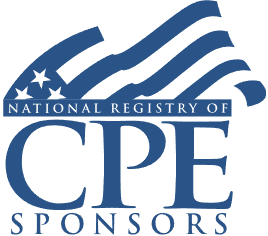Loss Limitations Analysis: Basis, At-Risk, Passive, and NOLs

Course Details
- smart_display Format
On-Demand
- signal_cellular_alt Difficulty Level
Intermediate
- work Practice Area
Tax Preparer
- event Date
Friday, November 1, 2024
- schedule Time
1:00 p.m. ET./10:00 a.m. PT
- timer Program Length
110 minutes
-
BARBRI is a NASBA CPE sponsor and this 110-minute webinar is accredited for 2.0 CPE credits.
-
BARBRI is an IRS-approved continuing education provider offering certified courses for Enrolled Agents (EA) and Tax Return Preparers (RTRP).
This course will discuss the hierarchy of basis, at-risk, passive activity loss (PAL) limitations, net operating loss (NOL) limitations, and steps to avoid and mitigate the limitation of losses for owners of partnerships and S corporations.
Faculty

Mr. Roberts is a tax litigator and trusted advisor with considerable experience helping U.S. and international clients successfully resolve all types of federal tax controversies involving civil or criminal liability, from tax audits and investigations to litigation, appeals and collection matters. Having served nearly three years as an attorney-advisor to the Chief Judge of the U.S. Tax Court in Washington, D.C., Mr. Roberts brings unique insight to navigating intricate government processes and developing innovative and cost-effective solutions to his clients’ tax problems. His client list spans many industries and ranges from individuals and entrepreneurs to non-profits, trusts and estates, partnerships and corporations.

Mr. Smeltzer is Board Certified in Tax Law by the Texas Board of Legal Specialization. He focuses his practice on defending taxpayers in all stages of civil and criminal tax proceedings, including sensitive audits and examinations. Mr. Smeltzer frequently represents corporations, complex partnerships, family offices, estates and trusts, and high-net worth individuals. His practice encompasses a variety of industries, with special expertise in real estate, energy, insurance, private equity, digital assets and blockchain technology. Mr. Smeltzer uses his background as a former U.S. Department of Justice lawyer to provide first-hand knowledge when the government is involved in litigation in designing an effective plan to litigate disputes, minimize risks and achieve as many client goals as possible. He has deep litigation and trial experience, both as a private and government lawyer, in controversies ranging from $500,000 to more than $1.5 billion.
Description
A multitude of limitations exist to delay the deduction of losses by taxpayers. Although most aim to prevent taxpayers' manipulation of losses, there are times when legitimate transactions result in nondeductible losses. Separating these allowed/deductible and unallowed/carried forward losses is complex.
Section 704(d) dictates that partnership losses exceeding basis at year-end must be suspended. The mirror provision for S corporations, Section 1366(d), states that shareholder losses are limited to the shareholder's adjusted basis in the stock plus his loans to the corporation. Excess losses are carried forward indefinitely. Although similar to basis limitations, Section 465 at-risk rules further limit losses requiring that the taxpayer be "at-risk" or personally liable for the amounts claimed as losses. The extent of this personal liability obligation is interpreted differently for shareholders and partners, adding further complications.
A deductible loss must pass through yet another hurdle--the PALs under Section 469. PALs are limited to the amount of passive income reported, so identifying passive income is critical. Understanding the interaction of basis, at-risk, passive, and NOLs is essential for tax practitioners looking to maximize loss deductions for taxpayers.
Listen as our panel of tax experts discusses the interplay of the many restrictions on loss deductions, including structuring opportunities to maximize the amount currently deductible.
Outline
- Basis
- At-risk limitations
- Passive loss limitations
- Net operating losses
- Section 461(l) excess business loss limitation
- Planning opportunities
Benefits
The panel will review these and other notable issues:
- The appropriate hierarchy for application of loss limitations
- What constitutes amounts at risk for partnerships and S corporations
- How can activities be aggregated to avoid PAL limitations?
- When losses are carried forward, and how are losses applied to different types of income?
NASBA Details
Learning Objectives
After completing this course, you will be able to:
- Ascertain whether inside basis, outside basis, or both are required to be adjusted
- Identify opportunities to group or aggregate trade and business activities
- Recognize the requirements for meeting the tax basis capital provisions
- Ascertain at-risk amounts
- Determine how the excess business loss is calculated
- Understand how the rules related to net operating losses are applied
- Field of Study: Taxes
- Level of Knowledge: Intermediate
- Advance Preparation: None
- Teaching Method: Seminar/Lecture
- Delivery Method: Group-Internet (via computer)
- Attendance Monitoring Method: Attendance is monitored electronically via a participant's PIN and through a series of attendance verification prompts displayed throughout the program
- Prerequisite: Three years+ business or public firm experience preparing complex tax forms and schedules, supervising other preparers or accountants. Specific knowledge and understanding of pass-through taxation, including taxation of partnerships, S corporations and sole proprietorships, qualified business income, net operating losses and loss limitations; familiarity with net operating loss carry-backs, carry-forwards and carried interests.

Strafford Publications, Inc. is registered with the National Association of State Boards of Accountancy (NASBA) as a sponsor of continuing professional education on the National Registry of CPE Sponsors. State boards of Accountancy have final authority on the acceptance of individual courses for CPE Credits. Complaints regarding registered sponsons may be submitted to NASBA through its website: www.nasbaregistry.org.

Strafford is an IRS-approved continuing education provider offering certified courses for Enrolled Agents (EA) and Tax Return Preparers (RTRP).
Unlimited access to premium CLE courses:
- Annual access
- Available live and on-demand
- Best for attorneys and legal professionals
Unlimited access to premium CPE courses.:
- Annual access
- Available live and on-demand
- Best for CPAs and tax professionals
Unlimited access to premium CLE, CPE, Professional Skills and Practice-Ready courses.:
- Annual access
- Available live and on-demand
- Best for legal, accounting, and tax professionals
Unlimited access to Professional Skills and Practice-Ready courses:
- Annual access
- Available on-demand
- Best for new attorneys
Related Courses

Admitting New Partners: Tax Consequences
Friday, May 30, 2025
1:00 p.m. ET./10:00 a.m. PT

Key Issues in Succession Planning: Buy-Sell Agreements, Equity Grants, Profits Interests, Tax Considerations
Tuesday, June 17, 2025
1:00 p.m. ET./10:00 a.m. PT
Recommended Resources
How CPE Can Bridge the Gap Between What You Know and What You Need to Know
- Career Advancement